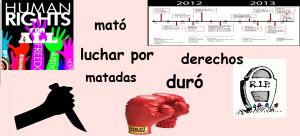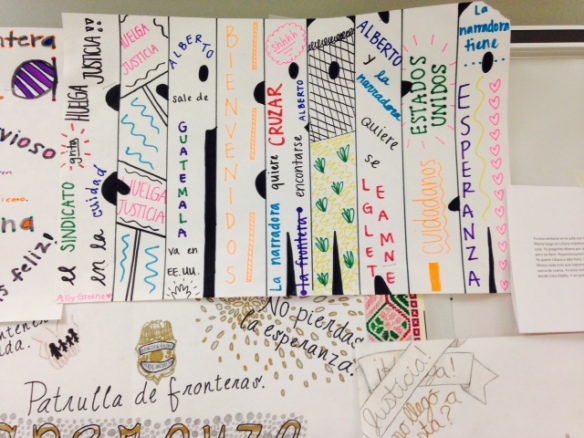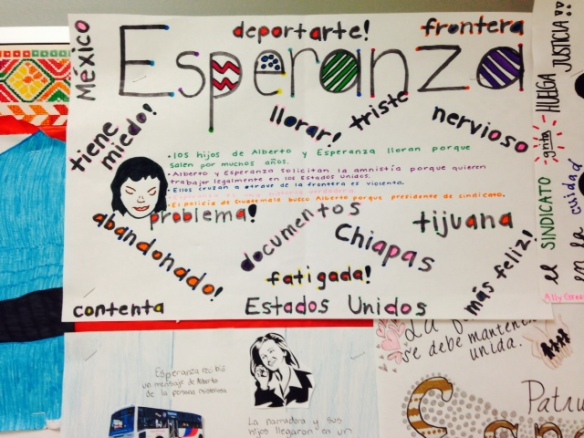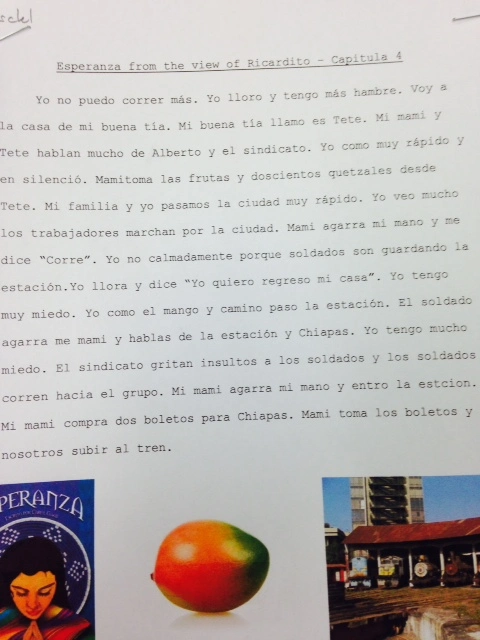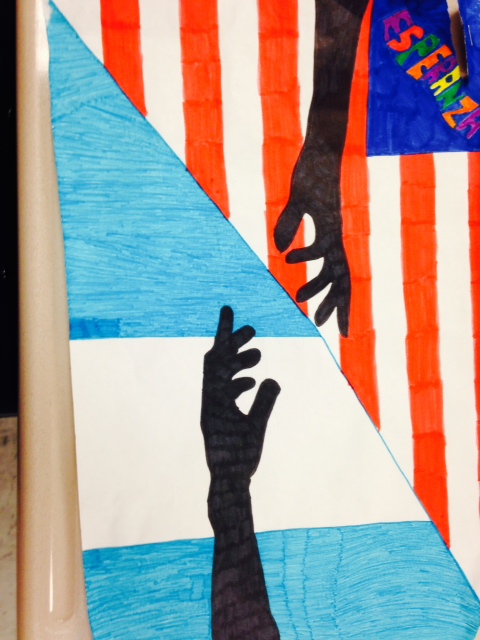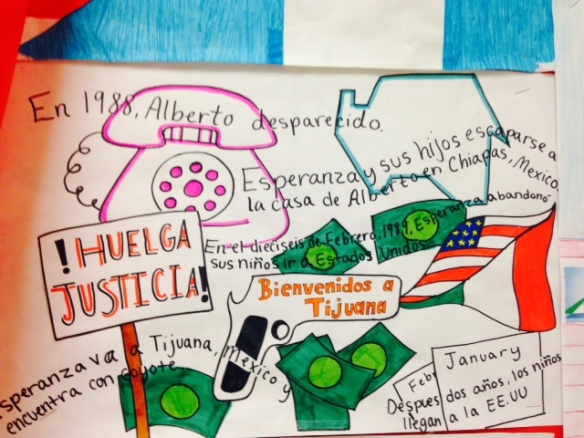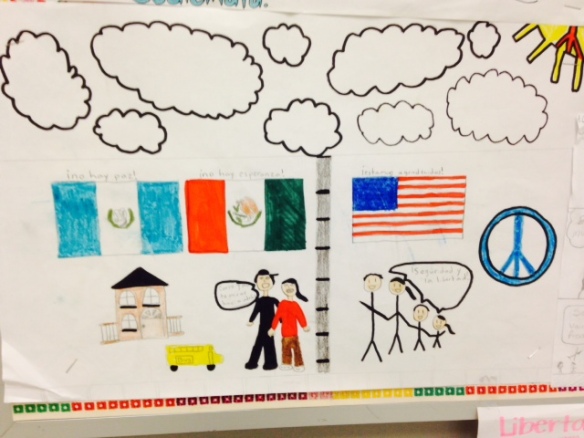This is the 4th year that I have used the TPRS Storytelling novel, Esperanza (Carol Gaab) with Spanish III as the first novel of the year. Although it may sound ridiculous, I am loving this novel more than ever! However, the point of this post is not to detail all of the things that I am doing the same as well as differently. Rather, I am going to share, once again, a favorite song that I use with the novel and the updates that I have done with it. The song is Ave que emigra by Gaby Moreno (from Guatemala).
The previous three years the song was a hit with most of the students in my classes, but this year it became a guiding piece of pre-teaching as well as a continuing presence during the novel. Additionally, there is a new Gaby Moreno song out called Guatemorfosis that will provide a hopeful focus as we finish the novel.
This year, in conjunction with my “Intro to Guatemala” cultural component, I used a story that I wrote that was based on the song. We started this one the very first day of our Guatemala study. I literally used the lyrics that Gaby Moreno wrote in the song to create the story, incorporating some of them directly into the story. The results were wonderful. I spent 2 days with the story prior to introducing the song. The first activity with the actual song is to watch about a minute 10 seconds of the video, just checking what they see. We briefly talk about the images that they have seen.
 We then listen to the first part of the song, putting the first 7 lines in order. After that, we talked about what those lyrics meant. This year, there was no need to elaborate on new vocabulary or to explain what “Guate” was. The students knew exactly what the lyrics were saying because of the story that we had read. Students answered some basic questions about the singer and the song, completed a simple cloze, worked with synonyms and antonyms, and did a personal reflection about what they thought the title of the song meant and what it might mean in terms of the novel that were going to be reading. We also did a partner ordering of the song lyrics on another day, using big sentence strips on cardstock. An additional homework assignment was to illustrate their choice of three lines of the song. I brought the song back again in chapter 4, as the family prepares to leave for Chiapas (we spent quite some time on Chiapas and its’ relationship historically with Guatemala/Mexico), using an interview with Gaby, a close look at the lyrics (especially Cansados de estar corriendo En tiempos de cacería ) and the official video for the first time.
We then listen to the first part of the song, putting the first 7 lines in order. After that, we talked about what those lyrics meant. This year, there was no need to elaborate on new vocabulary or to explain what “Guate” was. The students knew exactly what the lyrics were saying because of the story that we had read. Students answered some basic questions about the singer and the song, completed a simple cloze, worked with synonyms and antonyms, and did a personal reflection about what they thought the title of the song meant and what it might mean in terms of the novel that were going to be reading. We also did a partner ordering of the song lyrics on another day, using big sentence strips on cardstock. An additional homework assignment was to illustrate their choice of three lines of the song. I brought the song back again in chapter 4, as the family prepares to leave for Chiapas (we spent quite some time on Chiapas and its’ relationship historically with Guatemala/Mexico), using an interview with Gaby, a close look at the lyrics (especially Cansados de estar corriendo En tiempos de cacería ) and the official video for the first time.
I was so excited this summer to discover that Gaby, as part of a Pepsi campaign in Guatemala, had released a new song. There is an entire site devoted to Guatemorfosis: El cambio #YosoyGuatemoforsis, with many stories from people in Guatemala who are creating change for the country. The song is a HUGE hit in my classes. The kids love the music and her voice. It is a really catchy tune! I have not yet worked with the lyrics with the classes yet since I want to keep this as an end activity when they know that the family has made it to the United States. I will use the song to bring the focus to present day Guatemala and the hopeful state of mind that is beginning to emerge after the decades of Civil War and the troubling years after that. One activity that I know I will use once the students have learned the lyrics will be this matching activity guatemoforsis-through-images. I will run off sets of the pictures for groups of two. They will be cut and placed in a baggie. I will play the song and the students will arrange the pictures to go with the lyrics of the song. There will be other activities, I just haven’t gotten to that point yet!
The song is so new that the lyrics are not available on line yet, so here they are, to the best of my ability (which means there may be errors!):
Hay un camino que nos trajo hasta aquí
No conoce las fronteras de esta pasion dentro de mi
Es anhelo el que me empuja cada nuevo amanecer
Con mis temores y ilusiones y los restos de ayer
uuuuuuuuhhhhhhhh
La esperanza nos acompaña
Con ella nada nos puede detener
Yo de tu mano
Tu de la mía
No hay nada que temer
Y río y bailo
Está en mis venas
Y libre sueño
Yo pertenezco aquí
Quién sabe
lo que el mañananos quisiera regalar
Hoy es todo lo que tengo
Y lo voy a atesorar
Poniendo en manifiesto cuanta luz puedo irridiar
Y ser feliz es el remedio
Que todo lo pueden mejorar
Y río y bailo
Está en mis venas
Y libre sueño
Yo pertenezco aquí
Y río y bailo
Está en mis venas
Y libre sueño
Hasta el final seguiré

 I have written so many times about music and my teaching. I literally have been using music in my classes for the past 37 years! Yes, I know, I’m ancient. What doesn’t ever get ancient is the music. This post is going to be a bit different. I’m trying to consolidate; instead of writing a post about a specific unit I am going to simply list all of my units and the music that anchors each of them. There is NOT ONE unit that doesn’t begin with music, not one. Music is always part of my “hook”. It may not be the only hook, but it always is one of the hooks and the music “plays” on throughout the entire unit.
I have written so many times about music and my teaching. I literally have been using music in my classes for the past 37 years! Yes, I know, I’m ancient. What doesn’t ever get ancient is the music. This post is going to be a bit different. I’m trying to consolidate; instead of writing a post about a specific unit I am going to simply list all of my units and the music that anchors each of them. There is NOT ONE unit that doesn’t begin with music, not one. Music is always part of my “hook”. It may not be the only hook, but it always is one of the hooks and the music “plays” on throughout the entire unit.





